Complete Solutions to Unsolved Numberical Problems of chapter ELECTROSTATICS of Class 12 book with complete answers and questions
| Class 12 | PHYSICS |
| Chapter | ELECTROSTATICS |
| PHYSICS GALAXY | Unsolved Numberical Problems |
| Number Of Questions | 73 |
| Academic Year | 2023-24 |
A small sphere is charged uniformly and placed at point A (u, v) so that at point B (8, 7) electric field strength is` vecE = (54 hati + 72hatj)` N/C and potential is+ 900V. Calculate:
(a) Magnitude of charge,
(b) Co-ordinates of point A, and
(c ) If di-electric strength ofair is `3 xx I0^(6)` V/m, minimum possible radius of the sphere.12:39View SolutionThe electric intensity Eat a point on the axis ofa ring of radius a at a distance x from its centre is given by
`(1)/(4piepsi_(0))(qx)/((a^(2)+x^(2))^(3//2))`
where q is charge on ring.
An electron is constrained to move along the axis of this ring. Show that the electron can perform oscillations whose frequency is given by
`omega=((eq)/(4piepsi_(0)ma^(3)))^(1//3)`
Where e is the charge on electron:04:00View SolutionTwo long wires each oflength I are placed on a smooth horizontal table. Wires have equal but opposite charges. Magnitude oflinear charge density on each wire is `lambda`. Calculate the work required to increase the separation between the wires from a to 2a:
04:14View SolutionFour charges `+50 xxI0^(-9)C, -12 xx I0^(-19)C, + 36 xx I0^(-9)C " and " +90 x 10^(-9)C` are placed respectively at the corners of a rectangula: ABCD,AB being equal to 5cm and BC being 12cm. Find:
(a) the force on the charge at A, and
(b) the field strength at the point of intersection of the two diagonals02:53View SolutionA solid conducting sphere of radius R is placed in a uniform electric field E as showo in figure. Due to electric field non uniform surface charges are induced on the surface of the sphere. Consider a point A on the surface of sphere at a polar angle `theta` from the direction of electric field as shown in figure. Find the surface density of induced charges at point A in terms of electric field and polar angle `theta` : lt brgt
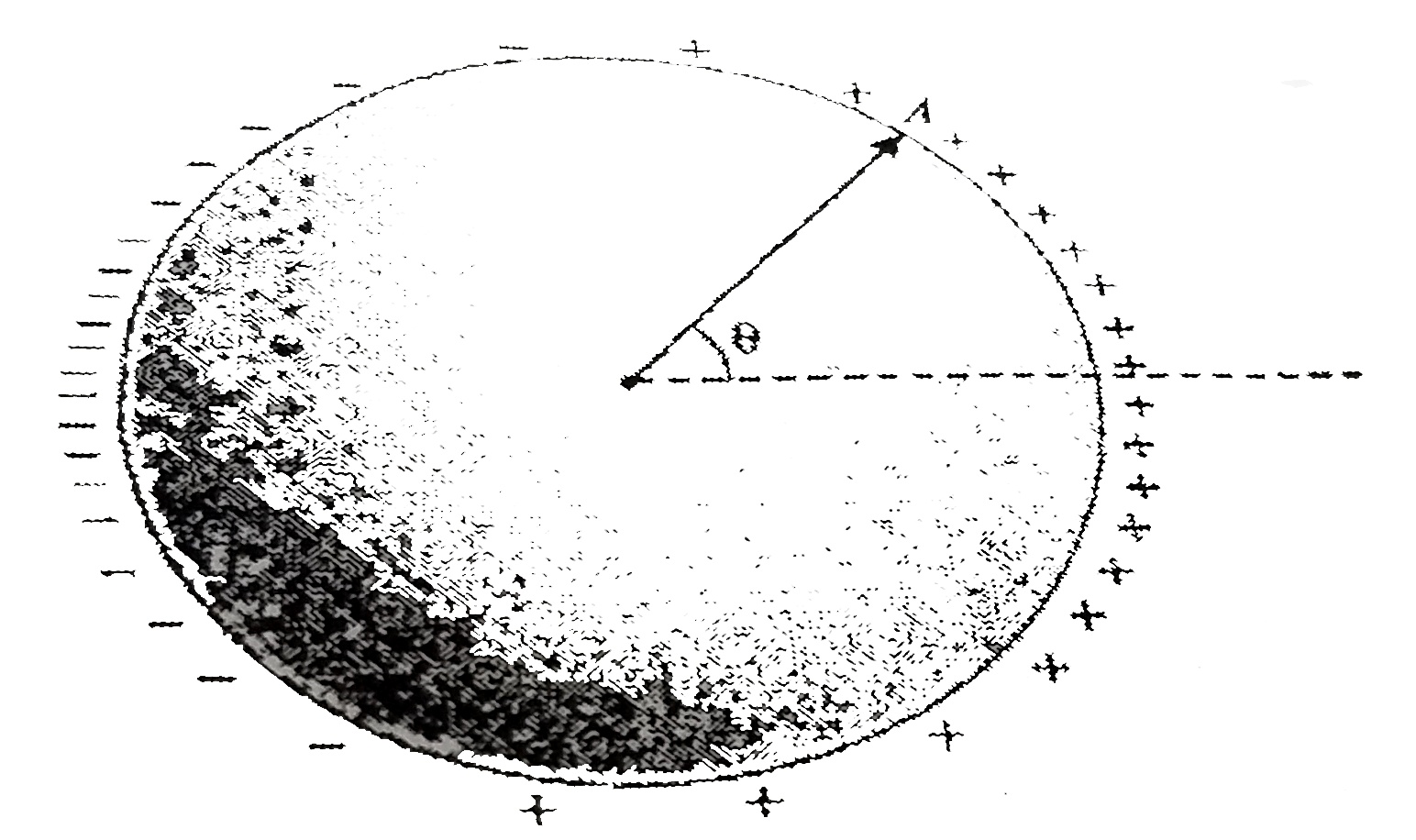 View Solution
View SolutionSuppose in an insulating medium, having di-electric constant k= 1, volume density of positive charge varies with y-coordinate according to law `rho = ay`. A particle of mass m having positive charge q is placed in the medium at point A `(0,y_(0))`J and projected with velocity `vecv = v_(0)hati` as shown in figure. Neglecting gravity and frictional resistance of the medium and assuming electric field strength to be zero at y = 0, calculate slope of trajectory of the particle as a function of y :
 15:05View Solution
15:05View SolutionTwo short dipoles `phat(k)` and `P/2 hat(k)` are located at `(0,0,0)` & `(1m, 0,2m)` respectivley. The resultant electric field due to the two dipoles at the point `(1m, 0,0)` is
05:25View SolutionTwo long straight parallel wires carry charges `lambda_(1) and lamda_(2)` per unit length. The distance between them is d. Calculate the magnitude of force externed on the length of one due to charge on the other.
01:34View SolutionFind the magnitude of uniform electric field E of which the direction is shown in figure if an electron entering with velocity l00m/s making `30^(@)` comes out making `60^(@)` , after a time numerically equal to m/e ofelectron where m is mass ofelectron and e is electronic charge :
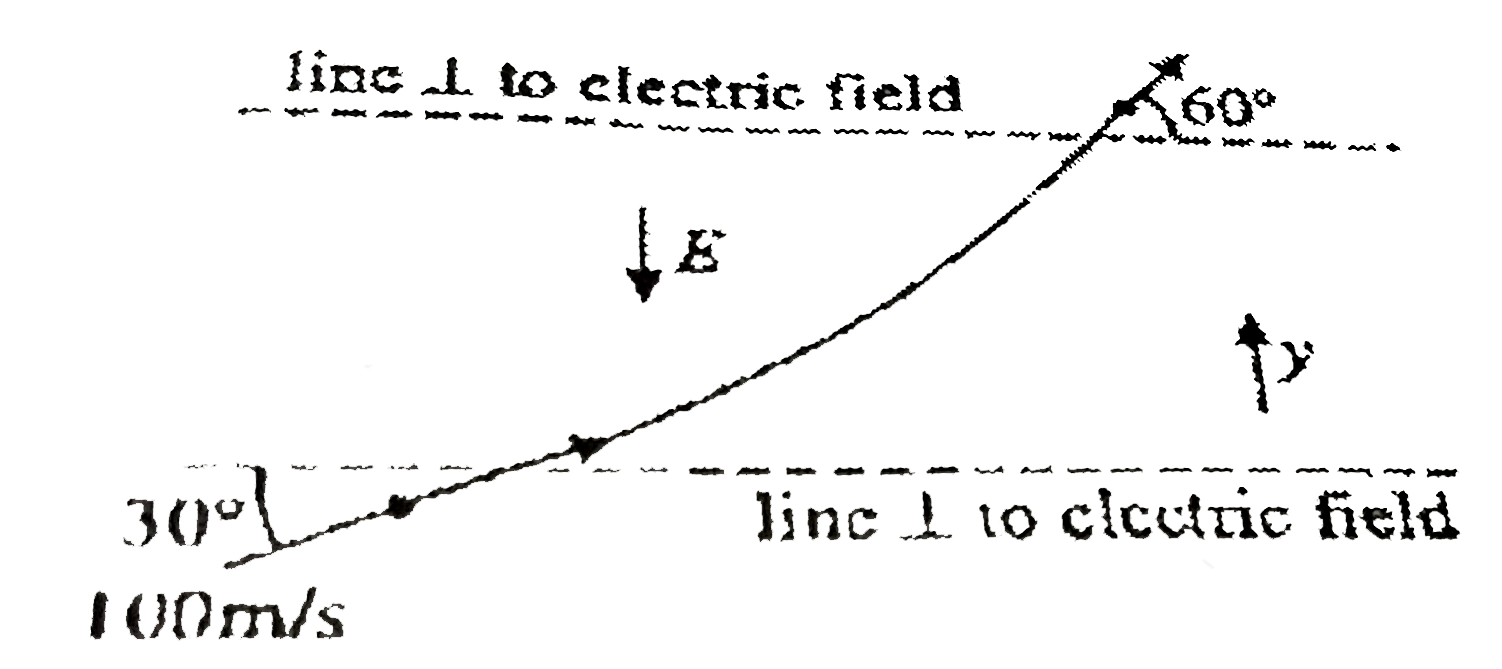 07:04View Solution
07:04View SolutionTwo short electric dipoles having dipole moment `p_(1)" and "p_(2)` are placed co-axially and uni-directionally, at a distance r apart. Calculate nature and magnitude of force between them :
06:55View SolutionThree identically charged, small spheres each of mass m are suspended from a common point by insulated light strings each of length I. The spheres are always on vertices of an equilateral triangle of length of the sides `x (ltlt l)`. Calculate the rate dq/ dt with which charge on each sphere increases if length of the sides of the equilateral triangle increases slowly according to law `(dx)/(dt)=(a)/(sqrt(x))`
05:35View SolutionTwo horizontal parallel conducting plates are kept at a separation `d = 1.5 xx 10^(-2) m` apart one above the other in air as shown in figure. The upper plate is maintained at a positive potential of `1.5 kV`while the other plate is earthed which maintains it at zero potential. Calculate the number of electrons which must be attached to a small oil drop of mass `m =4.9 xx 10^(-15) kg` between the plates to maintain it at rest. Consider density of air is negligible in comparison with that ofoil. If the potential of above plate is suddenly changed to `-l .5kV`, what will be the initial acceleration of the charged drop? Also calculate the terminal velocity of the drop if its radius is `r= 5.0 xx 10^(-6)m` and the coefficient of viscosity of air is `eta = 1.8 x 10--5 N-s//m^(2) [3,2g, 5.7 xx 10^(-5) m//s^(2)]`
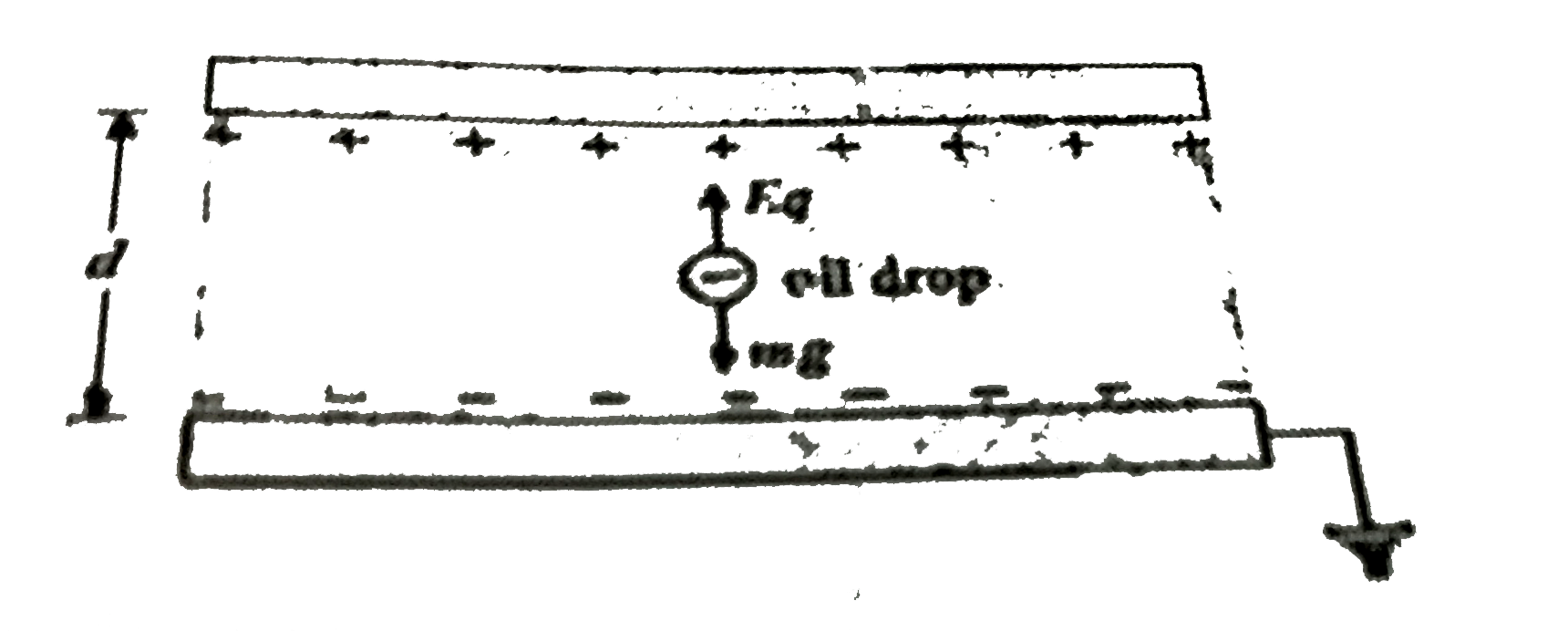 08:46View Solution
08:46View SolutionA small cork ball A of mass m is suspended by a thread of length I. Another ball B is fixed at a distance I from point of suspension and distance l/2 from thread when is vertical, as shown in figure-1.444. Balls A and B have charges (+ q) each. Ball A is held by an external force such that the thread remains vertical.
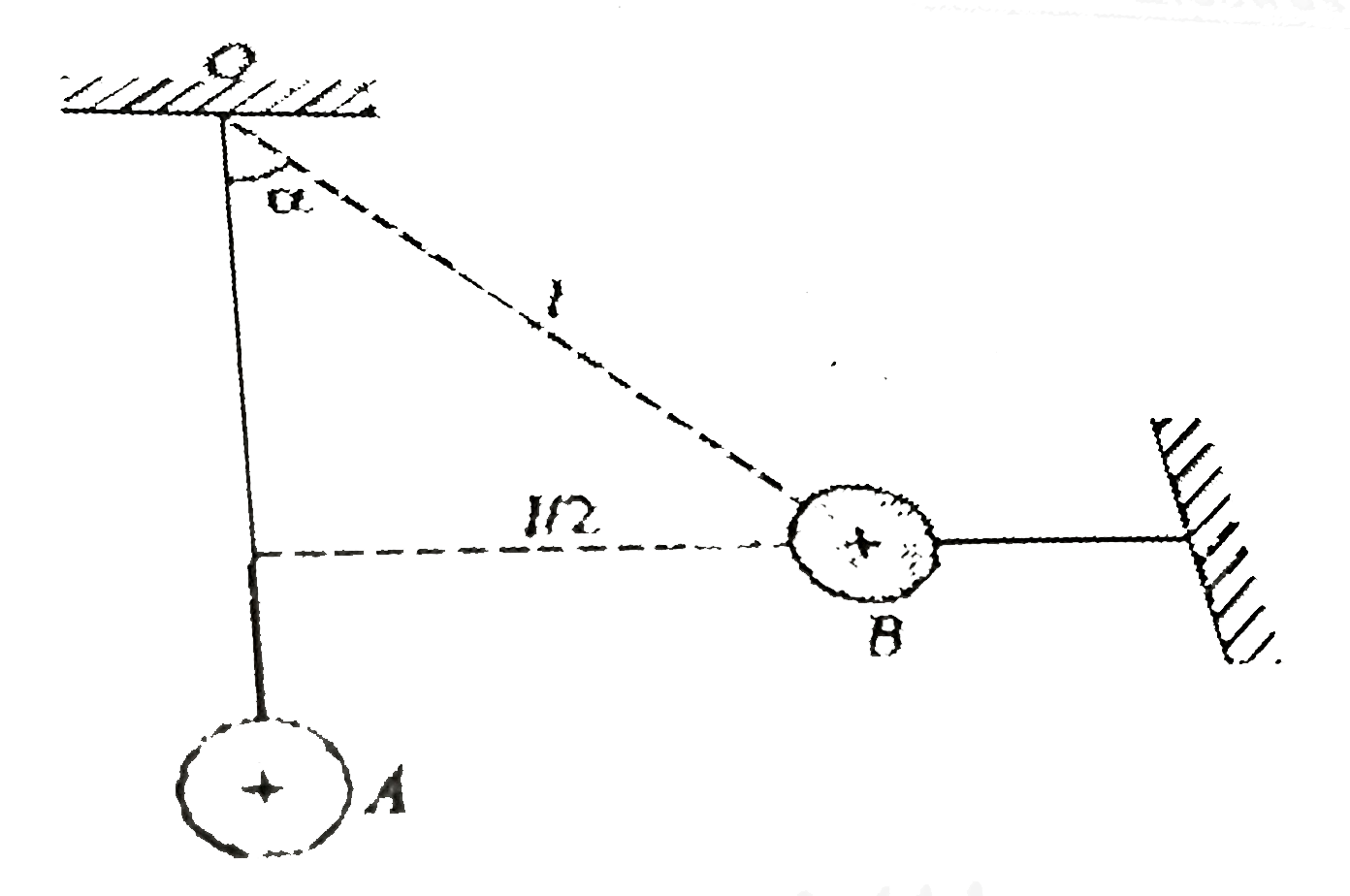
When ball A is released from rest, thread deflects through a . maximum angle of `beta = 30^(@)`, calculate m in terms of other parameters10:45View SolutionA particle of mass m having negative charge q moves along an ellipse around a fixed positive charge Q so that its maximum and minimum distances from fixed charge are equal to `r_(1) " and " r_(2)` respectively. Calculate angular momentum L of this particle:
View SolutionTwo concentric spheres of radii `R` and `2R` are charged. The inner sphere has a charge if `1muC` and the outer sphere has a charge of `2muC` of the same sigh. The potential is `9000 V` at a distance `3R` from the common centre. The value of R is
01:55View SolutionA charged particle of radius `5xx10^(-7)m` is located in a horizontal electric field of intensity `6.28xx10^(5)Vm^(-1)`. The surrounding medium has the coefficient of viscosity `eta=1.6xx10^(5)Nsm^(-2)`. The particle starts moving under the effect of electric field and finally attains a uniform horizontal speed of `0.02 ms^(-1)`. Find the number of electrons on it. Assume gravity free space.
04:13View SolutionTwo small balls having the same mass and charge and located on the same vertical at heights `h_(1)` and `h_(2)` are thrown in the same direction along the horizontal at the same velocity v. The first ball touches the ground at a horizontal distance R from the initial vertical position. At what height `h_(2)` will the second ball be at this instant? Neglect any frictional resistance of air and the effect of any induced charge on the ground.
04:22View SolutionWhat is the percentage change in distance if the force of attraction between two point charges increases to 4 times keeping magnitude of charges constant ?
02:36View Solutiontwo concentric rings of radii `r` and `2r`are placed with centre at origin. Tow charges ` +q` each are fixed at the diametrically opposite points of the rings as shown in figure . Smaller ring is now rotated by an angle ` 90^@` about Z-axis then it is again rotated by ` 90^@` about Y-axis . Find the work done by electrostatic forces in each step . If finally larger ring is rotated by `90^@` about X-axis , find the total work required to perform all three steps .
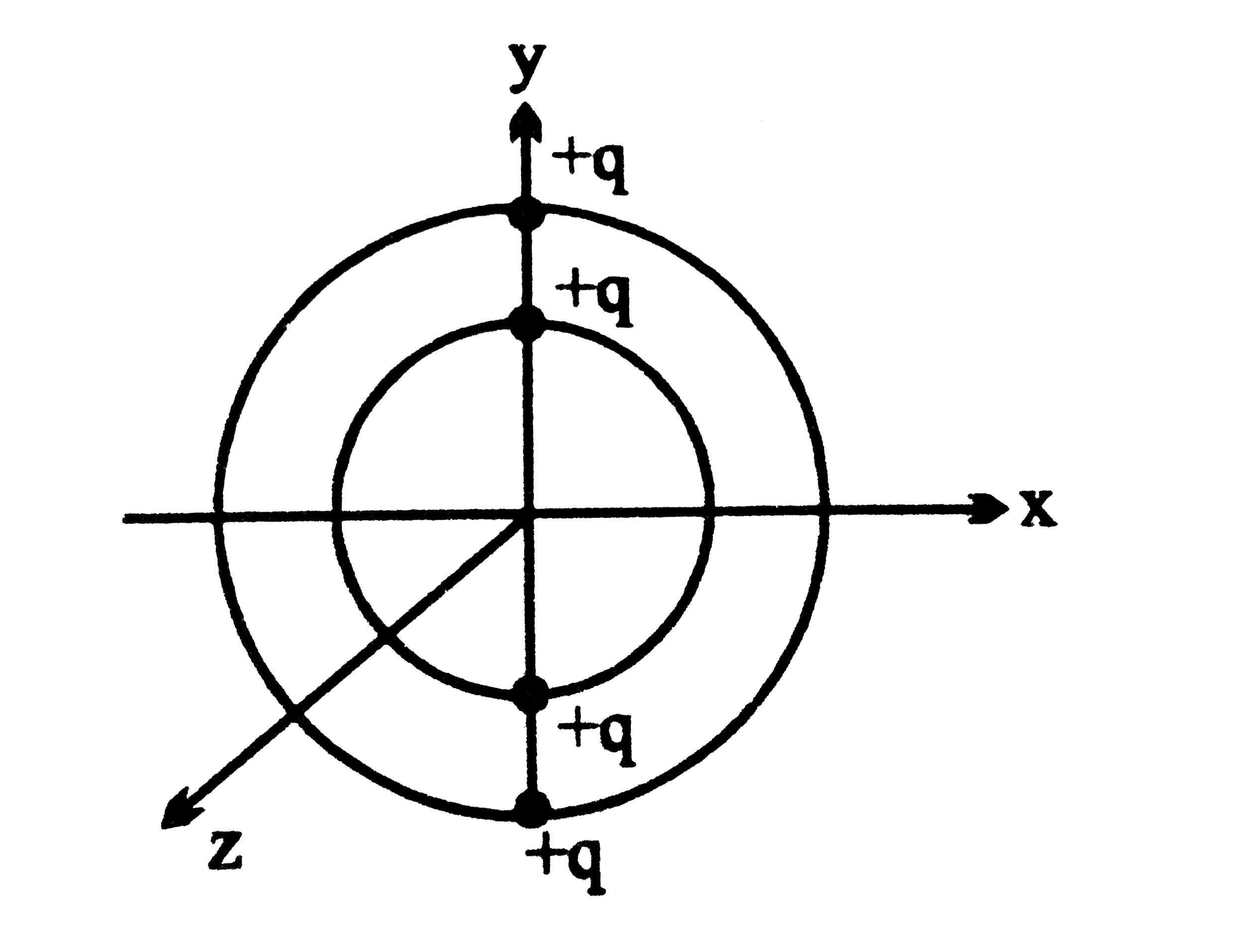 .13:44View Solution
.13:44View SolutionFind the electric field strength vector at the centre of a ball of raiduius `R` with volume charge density `rho implies ar`, where `a` is a constant vector, and `r` is a radius vector drawn from the ball's centre.
10:50View SolutionA positively charged sphere of mass m = 5kg is attached by a spring of force constant `K = 10^(4)` N/m. The sphere is tied with a thread so that spring is in its natural length. Another identical, negatively charged sphere is fixed with floor, vertically below the positively charged sphere as shown in fignre. If initial separation between sphere is `r_(0)` = 50cm and magnitnde ofcharge on each sphere is `q = 100muC`, calculate maximum elongation of spring when the thread is burnt. Take `g= 10 m//s^(2)` :
 View Solution
View SolutionThe figure shows thrednfinite non-conducting plates of charge perpendicular to the plane of the paper with charge per unit area `+sigma, + 2sigma" and " -sigma ` . Find the ratio of the net electric field atthat point A to that at point B. The points A and Bare located midway between the plates :
 03:55View Solution
03:55View SolutionA ball of radius `R` is uniformly charged with the volume density `rho`. Find the flux if the electric field strength vector across the balls section formed by the plane located at a distance `r_(0) lt R` from the centre of the ball.
07:21View SolutionSmall identical balls with equal charges are fixed at vertices of regular 2009 -gon with side a. At a certain instant, one of the balls is released & a sufficiently long time interval later, the ball adjacent to the first released ball is freed. The kinetic energies of the relased balls are found to differ by K at a sufficiently long distance from the polygon. Determine the charge q of each part.
05:16View SolutionAn infinitely long cylindrical surface density `sigma = sigma_(0) cos varphi`. Where `varphi` is the polar angle of the cylindrical coordinate system whose `z` axis coincides with the axis of the given surface. Find the magnitude and direction of the electric field strength vector on the `z` axis.
11:59View SolutionA non-conducting hollow sphere having inner and outer radii a and b respectively is made ofa material having di-electric constant K and has uniformly distributed charge over its entire solid volume. Volume density of charge is `rho` . Calculate potential at a distance r from its centre when :
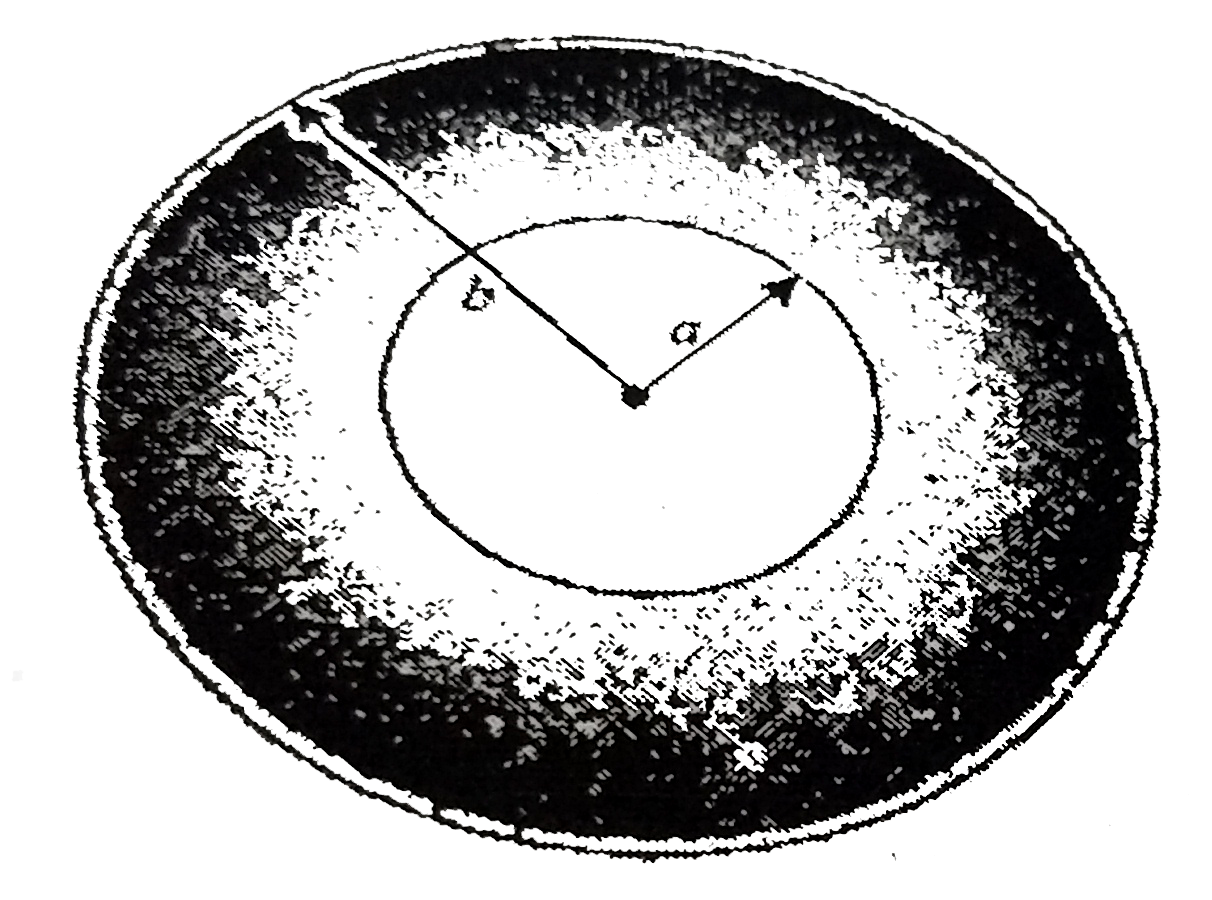
(a) `r gt b`,
(b) `r lt a`,
(c) `a lt r lt b`12:59View SolutionTwo thin parallel threads carry a uniform charge with linear densities `lambda` and `-lambda` . The distance between the threads is equal to `l`. Find the potential of the electric field and the magnitude of its strength vector at the distance `r gt gt l` at the angle `theta` to the vector 1 (fig).
 13:19View Solution
13:19View SolutionA positive charge Q is uniformly distributed throughout the volume of a dielectric sphere of radius R. A point mass having charge +q and mass m is fired toward the center of the sphere with velocity v from a point at distance `r (r gt R)` from the center of the sphere. Find the minimum velocity v so that it can penetrate `(R//2)` distance of the sphere. Neglect any resistance other than electric interaction. Charge on the small mass remains constant throughout the motion.
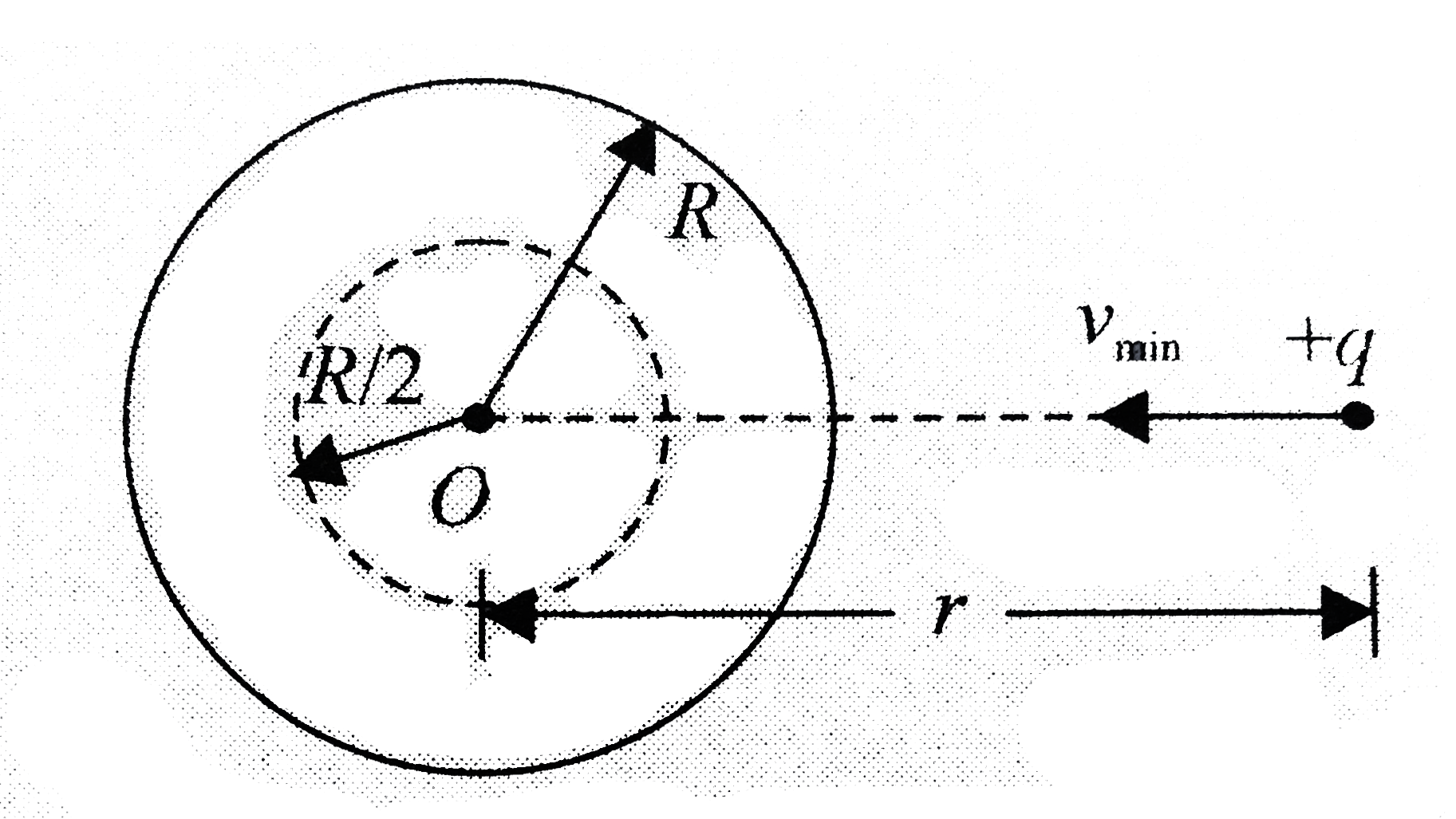 05:43View Solution
05:43View SolutionDistance between centres of two spheres A andB, each of radius R is r as shown in figure`-1.450`. SphereB has a spherical cavity of radius `R//2` such that distance of centre of cavity is (r-R/2) from the centre of sphere A and `R//2` from the centre of sphere B. Di-electric constant of material of each sphere is K = I and material of each sphere has a uniform charge density· p per unit volume. Calculate interaction energy of the two spheres :
 05:14View Solution
05:14View SolutionA clock face has charges `-q, -2q, ,.....-12q` fixed at the position of the corresponding numerals on the dial. The clock hands do not disturb the net field due to point charges. At what time does the hour hand point in the direction of the electric field at the centre of the dial.
08:24View SolutionA semi-circular ring of mass m and radius R with linear charge ilensity `lambda`, hinged at its centre. is placed in a uniform electric field as shown in the figure `-1.451`. Ifthe ring is slightly rotated about O and released find the time period (in sec) of oscillation. Take `m = 8 kg, lambda= 2 C//m` and `E = 2 N//c`. Assume that coil is rotated in its own plane
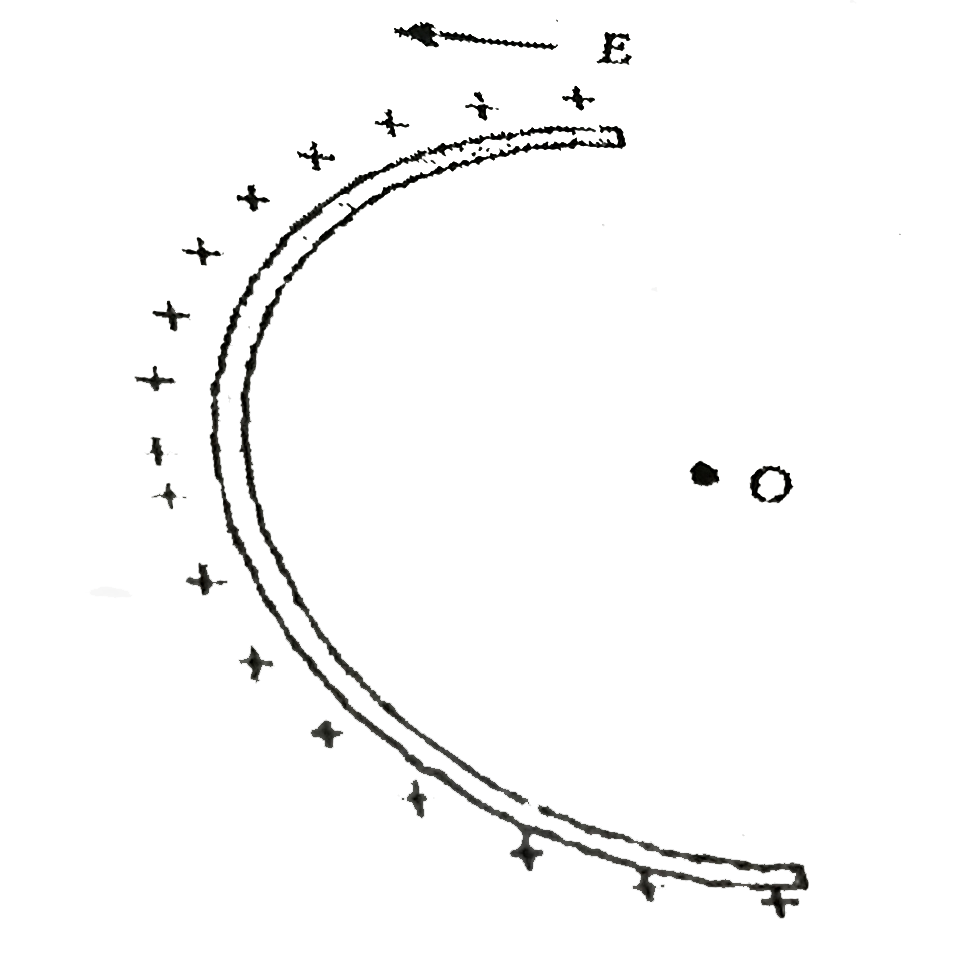 09:04View Solution
09:04View SolutionA charge ` + 10^-9 C` is located at the origin in free space `&` another charge ` Q` at ` (2,0,0)` . If the X-component of the electric field at (3,1,1) is zero , calculate the value of `Q`, Is the Y-component zero at (3,1,1) ?
06:46View SolutionTwo coaxial rings, each of radius R, made of thin wire are separated by a small distance `l(l lt lt R)` and carry the charges `q` and `-q`. Find the electric field potential and strength at the axis of the system as a function of the x coordinate (see figure). Investigate these functions at `|x| gt gt R`
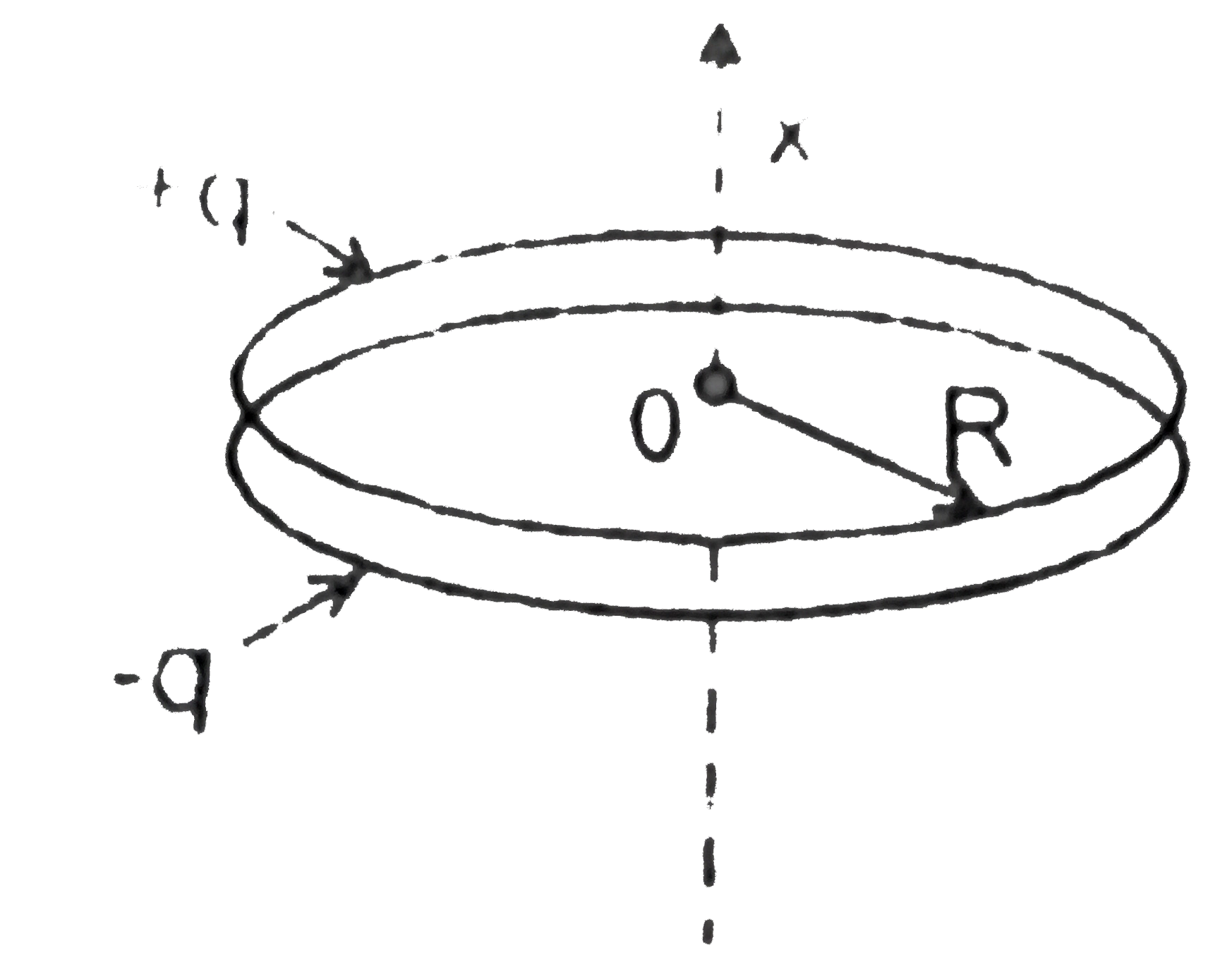 02:52View Solution
02:52View SolutionOn a thin rod oflength `l= 1 m`, lying along the x-axis with one end at the origin x = 0, there is uniformly distributed charge per unit length `lambda = Kx`, where K =constant `= 10^(-9) cm^(-2)` Find the work done in displacing a charge `q = 1000 muC` from a point `(0,sqrt(0.44 m)"to"(0, Im))`.
11:26View SolutionFind the interaction force between two water molecules separated by a distance `l = 10 mm` if their electric moments are oriented along the same straight line. The moment of each molecule equals `p = 0.62.10^(-29) C.m`.
02:47View SolutionA nonconducting sphere of radius `R = 5 cm` has its center at the origin O of the coordinate system as shown in (Fig. 3.112). It has two spherical cavities of radius `r = 1 cm`, whose centers are at `0,3 cm` and `0,-3 cm`, respectively, and solid material of the sphere has uniform positive charge density `rho = 1 // pi mu Cm^-3`. Calculate the electric potential at point `P (4 cm, 0)`.
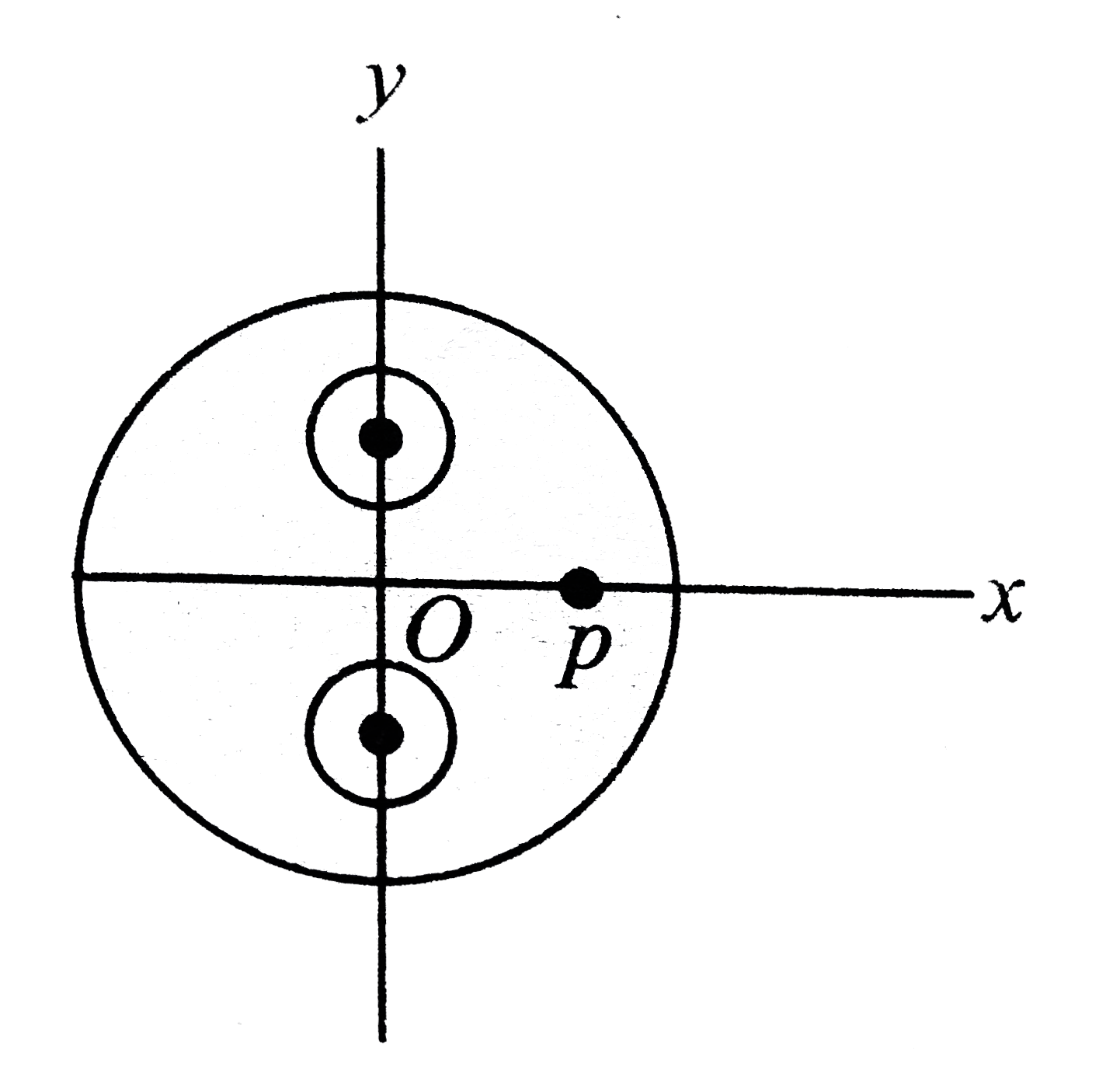 .06:47View Solution
.06:47View SolutionPositive and negative charges of `1 muC` each are placed at two points as shown in the figure. Find the potential difference between A and B
 02:57View Solution
02:57View SolutionThree particles, each of mass m and carrying a charge q each, are suspended from a common point by insulating mass-less strings each of length L. If the particles are in equilibrium and are located at the corners of an equilateral triangle of side a, calculate the charge q on each particle. Assume `Lgtgta`.
05:57View SolutionA uniformly distributed space charge fills up the space between two large parallel plates separated by a distance `d`. The potential difference between the plates is equal to zero ? What will then be the field strength near the other plate ?
05:12View SolutionConsider three identical metal spheres ` A, B` and `C`. Sphere `A` carries charge ` + 6q`, sphere `B` carries charge `-3q` and sphere `C` carries no charge . Spheres A and B are touched together and then separated. Sphere `C` is then touched to sphere `A` and separated from it . Finally the sphere `C` is touched to sphere `B` and separated from it . Find the final charge on the sphere `C`.
03:28View SolutionA copper atom consists of copper nucleus surrounded by `29` electrons. The atomic weight of copper is `63.5mol e^(-1)`. Let us now take two pieces of copper each weighing `10g`. Let us trandfer one elcetron from one piece to another for every `100` atoms in that piece. What will be the Coulomb force between the two pieces after the trandfer of electrons, if they are `1cm` apart? Avogadro number`= 6xx10^(23) mol e^(-1)`, charge on an electron `=-1.6xx10^(-19)C`.
07:33View SolutionA solid non-conducting hemisphere ofradius R has' a uniformly distributed positive charge of density p per unit volume. A negatively charged particle having charge q is transferred from centre of its base to infinity. Calculate workperformed.in the processc Di-electric constant of material of hemisphere is unity:
06:14View SolutionShow that, for a given dipole, V & E cannot have the same magnitude at distance less than 2m from the dipole. Suppose that the distance is `sqrt(5)m`, determine the directions along which V & E are equal in magnitude.
02:02View SolutionIn a conducting hollow sphere of inner and outer radii 5cm and 10cm respectively, a point charge 1 `mu`C is placed at point A, thaUs 3cm from the centre C of the hollow sphere. An external uniform electric field of magnitude 20 N/C is also applied. Net electric force on the this. charge is 15N, away from the away from the centre of the sphere as shown in figure`-1.455`. Find magnitude of force exerted by the charge placed at point A on the sphere:
 centre of the sphere as shown in figure. Find magnitude View Solution
centre of the sphere as shown in figure. Find magnitude View SolutionTwo circular rings A and B, each of radius a = 30cm, are placed coaxiallywith their axes vertical as shown in figure`-1 .456.` Distance between centres of these rings is `h = 40cm`. Lower ring A has a positive charge of ` 10mu`C, while upper ringB has a negative charge of `20muC.` A particle of mass `m = 100` gm carrying a positive charge of `q =10mu` C is released from rest at the centre of the ring ltbergt (a) Calculate initial acceleration of the particle.
(b) Calculate velocity of particle when it reaches at the centre ofupper ring B. `(g= 10 ms^(-2))`
 07:50View Solution
07:50View SolutionA hollow charged conductor has a tiny hole cut into its surface. Show that the electric field in the holes is `(sigma//2 in_(0)` `hat(n)`, where `hat(n)` is the unit vector in the outward normal direction, and `sigma` is the surface charge density near ther hole.
08:05View SolutionTwo point charges `q_(1)= 20 muC` and `q_(2)=25 muC` are placed at (-1, 1, 1) m and (3, 1, -2)m, with respect to a coordinate system. Find the magnitude and unit vector along electrostatic force on `q_(2)` ?
01:37View SolutionA spherical balloon of radius R charged uniformly on its surface with surface density `sigma`. Find work done against electric forces in expanding it upto radius 2R.
03:48View SolutionTwo similar helium-filled spherical balloons tied to a 5g weight with strings and each carrying a charge q floats in equilibrium as shown in figure`-1.457`. Find (a) the magnitude of q, assuming that the charge on each balloon acts as ifit were concentrated at the centre and (b) the volume of each balloon. Neglect weight of the unfilled balloons and take density ofair `1.29 kg//m^(3)` and the density of helium in the balloons `0.2 kg//m^(3):`
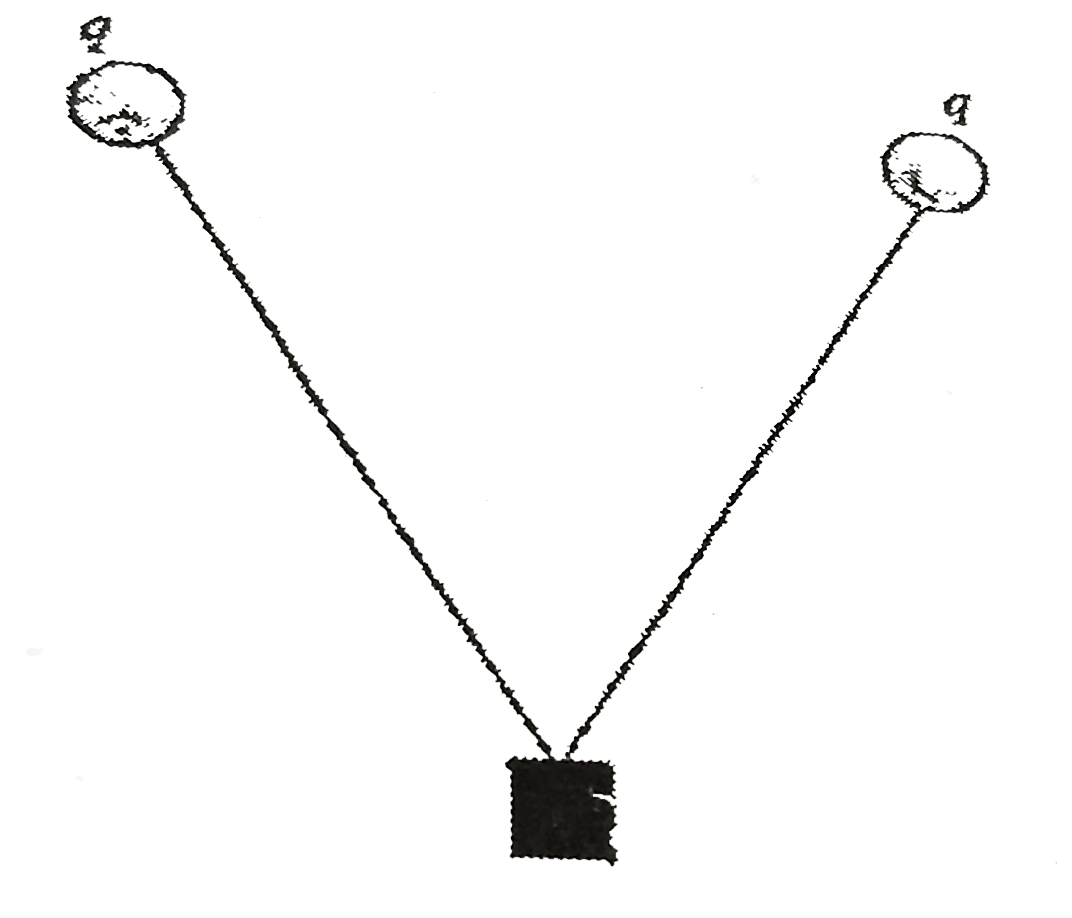 View Solution
View SolutionA simple pendulum of length `l` and bob mass `m` is hanging in front of a large nonconducting sheet having surface charge density `sigma`. If suddenly a charge `+q` is given to the bob `&` it is released from the position shown in figure. Find the maximum angle through which the string is deflected from vertical .
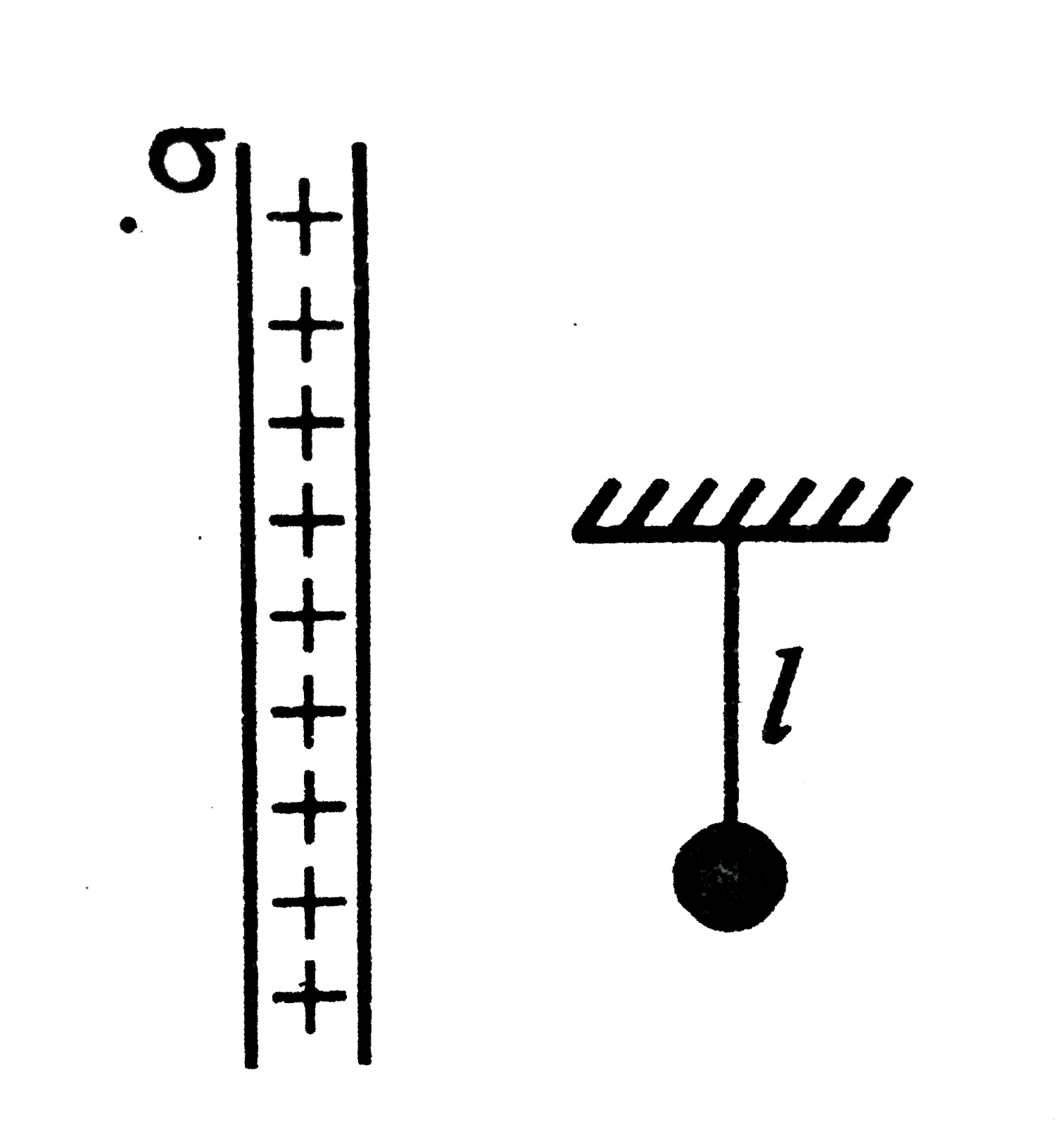 .04:35View Solution
.04:35View SolutionThe electric field in a region is given by `E=alphaxhati`. Here `alpha` is a constant of proper dimensions. Find
a. the total flux passing throug a cube bounded by the surface `x=l, x=2l, y=0, y=l, z=0, z=l`.
b. the charge contained inside in above cube.03:59View SolutionThe electric field in a region is given by `vecE=E_0x/iota veci`. Find the charge contained inside a cubical volume bounded by the curfaced `x=0, x=alpha, y=0, y=alpha, z=0 and z= alpha`. Take `E_0= 5 xx 10^3 N C^(-1)`, `l= 2cm and alpha=1 cm`.
06:11View SolutionWhen an uncharged conducting ball of radius `R` is placed in an external uniform electric field, a surface charge densityh `sigma = sigma_(0) cos theta` is induced on the ball's surface charge (here `sigma_(0)` is a constant, `theta` is a polar angle). Find the magnitude of the resultant electric force acting on an induced charge of the same sign.
10:54View SolutionTwo identical balls of charge `q_(1)` & `q_(2)` initially have equal of the same magnitude and direction. After a ubiform electric field is applied for some time, the direction of the velocity of the first ball charges by `60^(@)` and the magnitude is reduced by half. The direction of the velocity of the second ball charges there by `90^(@)`. In what proportion will the velocity of the second ball changes?
02:24View SolutionA positive charge `+Q` is fixed at a poibt A. Another positively charged particle of mass m and charge +q is projected from a point B with velocity u as shown in (Fig. 3.103). Point B is at a large distance from A and at distance d from the line A C. The initial velocity is parallel to the line A C. The point C is at a very large distance from A. Find the minimum distance (in meter) of +q from +Q during the motion. Take `Q q = 4 pi epsilon_0 m u^2 d` and `d (sqrt(2) - 1) m`.
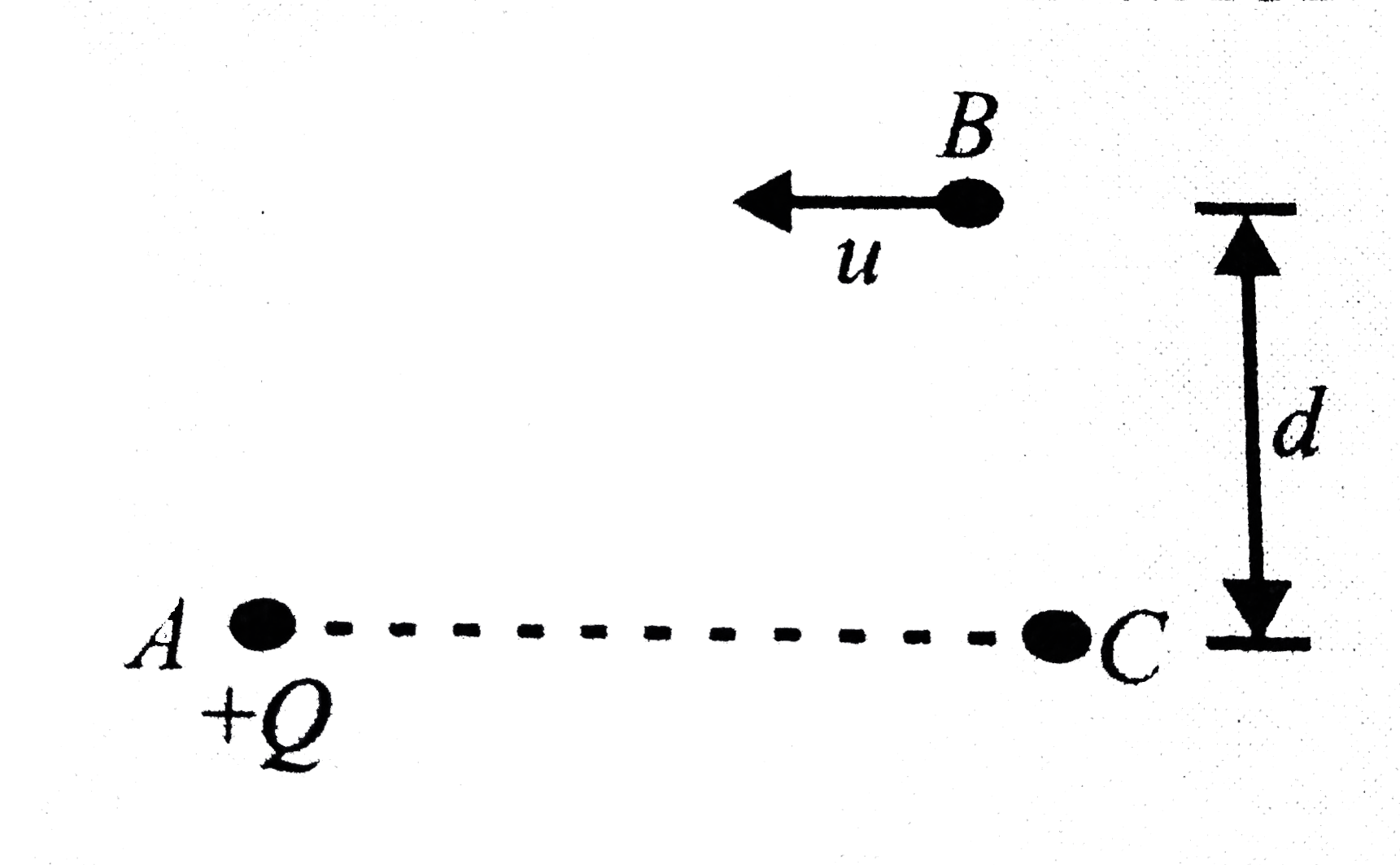 .09:06View Solution
.09:06View SolutionFigure shown a section through two long thin concentric cylinders of radii a & b with `a gt b`. The cylinders have equal and opposite per unit length `lambda`. Find the electric field at a distance r from the axis for (i) `r lt a` (ii) `a lt r lt b` (iii) `r gt b`
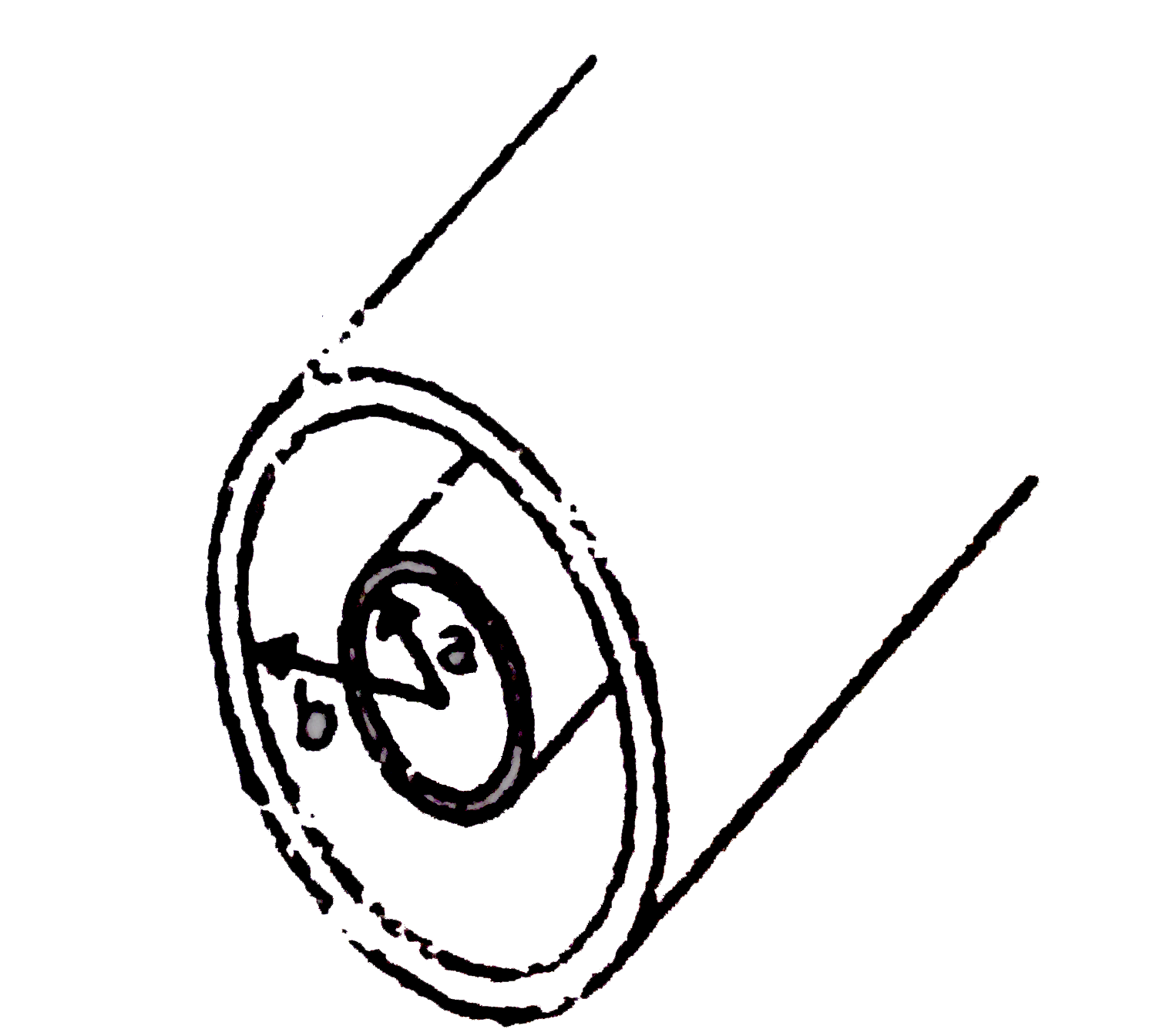 02:33View Solution
02:33View SolutionA point charge `Q` is located on the axis of disc of a radius `R` at a distance `a` from the plane of the disc . If one fourth `(1//4th)` of the flux from the charge passes through the disc, then find the relation between `a` & `R `.
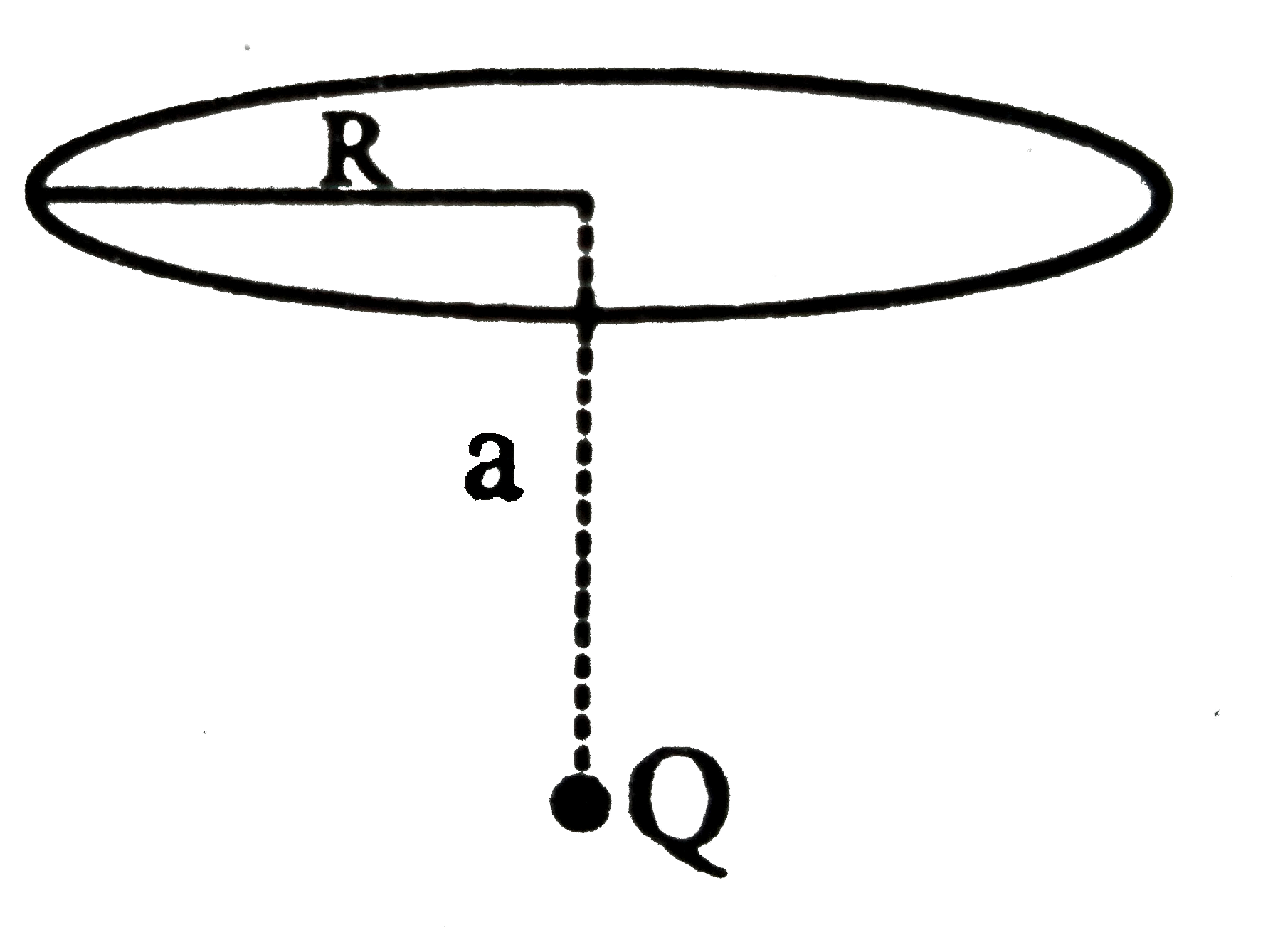 .08:53View Solution
.08:53View SolutionA very long uniformly charged thread oriented along the axis of a a circle of radius `R` rests on its centre with one of the ends. The charge of the thread per unit length is equal to `lambda`. Find the flux of the vector `E` across the circle area.
11:22View SolutionThree point charges of 1C, 2C and 3C are placed at the . corners of an equilateral triangle of side 1m. Calculate the work required to move these charges to the corners of a smaller equilateral triangle of side 1.5m.
08:42View SolutionTwo small metallic balls of radii `R_(1) & R_(2)` are kept in vacuum at a large distance compared to the radii. Find the ratio between the charges on the two balls at which electrostatic energy of the system is minimum. What is the potential difference between the two balls ? total charge of balls is constant.
02:32View SolutionTwo concentric spheres of radii `R` and `2R` are charged. The inner sphere has a charge if `1muC` and the outer sphere has a charge of `2muC` of the same sigh. The potential is `9000 V` at a distance `3R` from the common centre. The value of R is
01:55View SolutionA charge Q is uniformly distributed over a rod of length `l`. Consider a hypothetical cube of edge `l` with the centre of the cube at one end of the rod. Find the minimum possible flux of the electric field through the entire surface of the cube.
03:27View SolutionA particle having a charge of `q=8.85muC` is placed on the axis of a circular ring of radius `R=30cm` at a point `P` at a distance of `a=40cm` from the centre of the ring.The electric flux passing through the ring is `x xx 10^(5)N//C` .Find the value of `x`?
05:58View SolutionElectrically charged drops of mercury fall from an altitude h into a spherical metal vessel of radius R. There is a small opening in the upper part of the vessel. The mass of each drop is m, and the charge on the drop is Q. What will be the number n of the last drop that can still enter the sphere?
04:12View SolutionA non-conducting sphere ofradius R has a positive charge which is distributed over its volume with density `rho= rho_(0)(1- (x)/(R))` per unit volume, wherex is distance from the centre. If dielectric constant of material of the sphere is k= I, calculate energy stored in surrounding space and total self energy of the sphere:
View SolutionTwo identical charges, `5 muC` each are fixed at a distance 8 cm and a charged particle of mass `9 xx 10^(-6) kg` and charge `-10 muC` is placed at a distance 5 cm from each of them and is released. Find the speed of the particle when it is nearest to the two charges.
06:39View SolutionA particle of mass `m` and charge `-q` moves along a diameter of a uniformly charged sphere of radius `R ` and carrying a total charge ` +Q`. Find the frequency of S.H.M. of the particle if the amplitude does not exceed `R` .
03:27View SolutionTwo concentric conducting thin shells of radius R and 2 R carry charges +Q and +3Q respectively. The magnitude of electric field at a distance x outside and inside from the surface of outer sphere is same. Then the value of x is
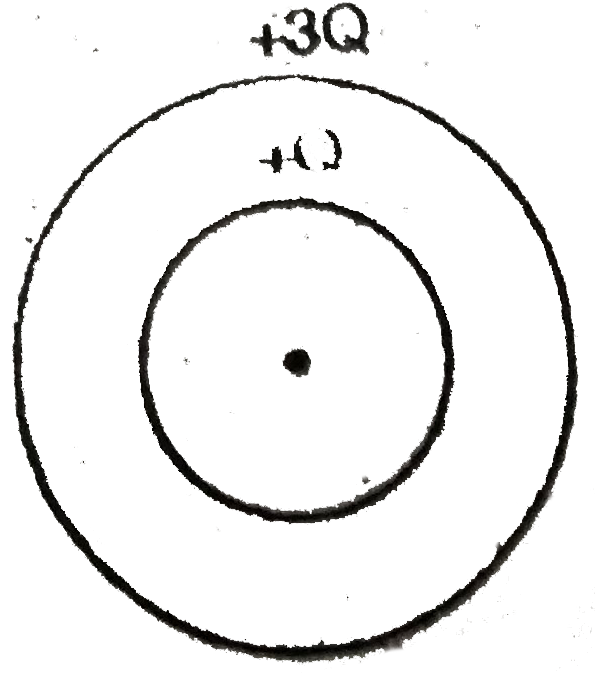 03:32View Solution
03:32View SolutionThe electric field strength depends only on the x and y coordinates according to the law E = `(a(xhati+ y hatj))/(x^(2) + y^(2))` , where a is a constant `hati` and `hatj` are unit vectors of the x and y axes . Find the potential difference between x = 1 and x = 5 :
05:30View SolutionA very long charged wire (lying in the xy plane ) which is having a linear charge density `lambda` is having one of its end at a point P as shown in figure . What is electric field intensity at point Q :
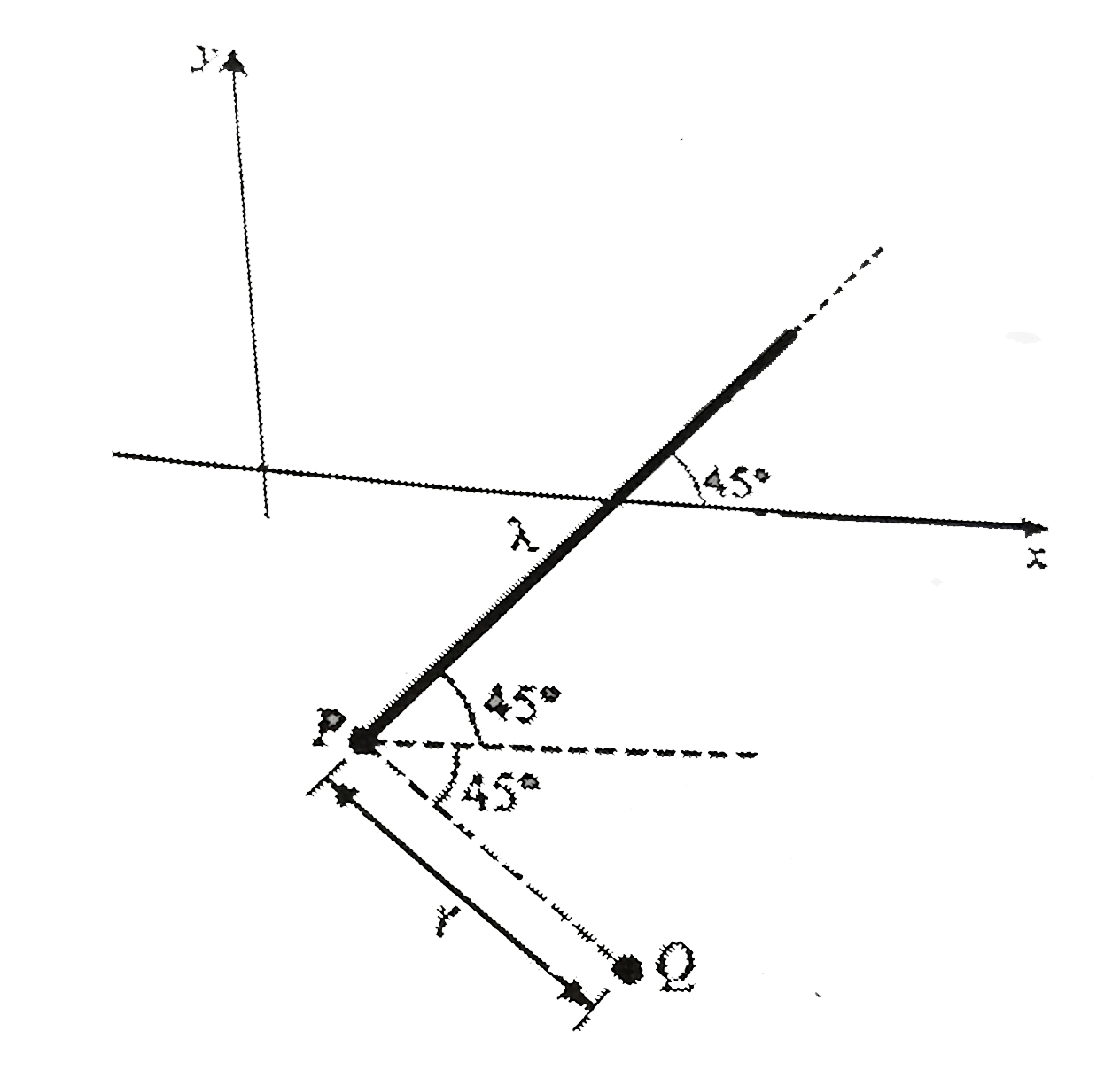 03:19View Solution
03:19View SolutionA solid sphere ofradius 'R' is uniformly charged with charge density `rho`in its volume. A spherical cavity of radius `(R)/(2)` is made in the sphere as shown in the figure. It is given that `(rhoR^(2))/(in_(0)) = 48 V`. Find the electric potential at the centre C of the sphere:
 06:50View Solution
06:50View SolutionFind the electric field at the origin due to the line charge (ABCD) of linear charge density `lambda`,
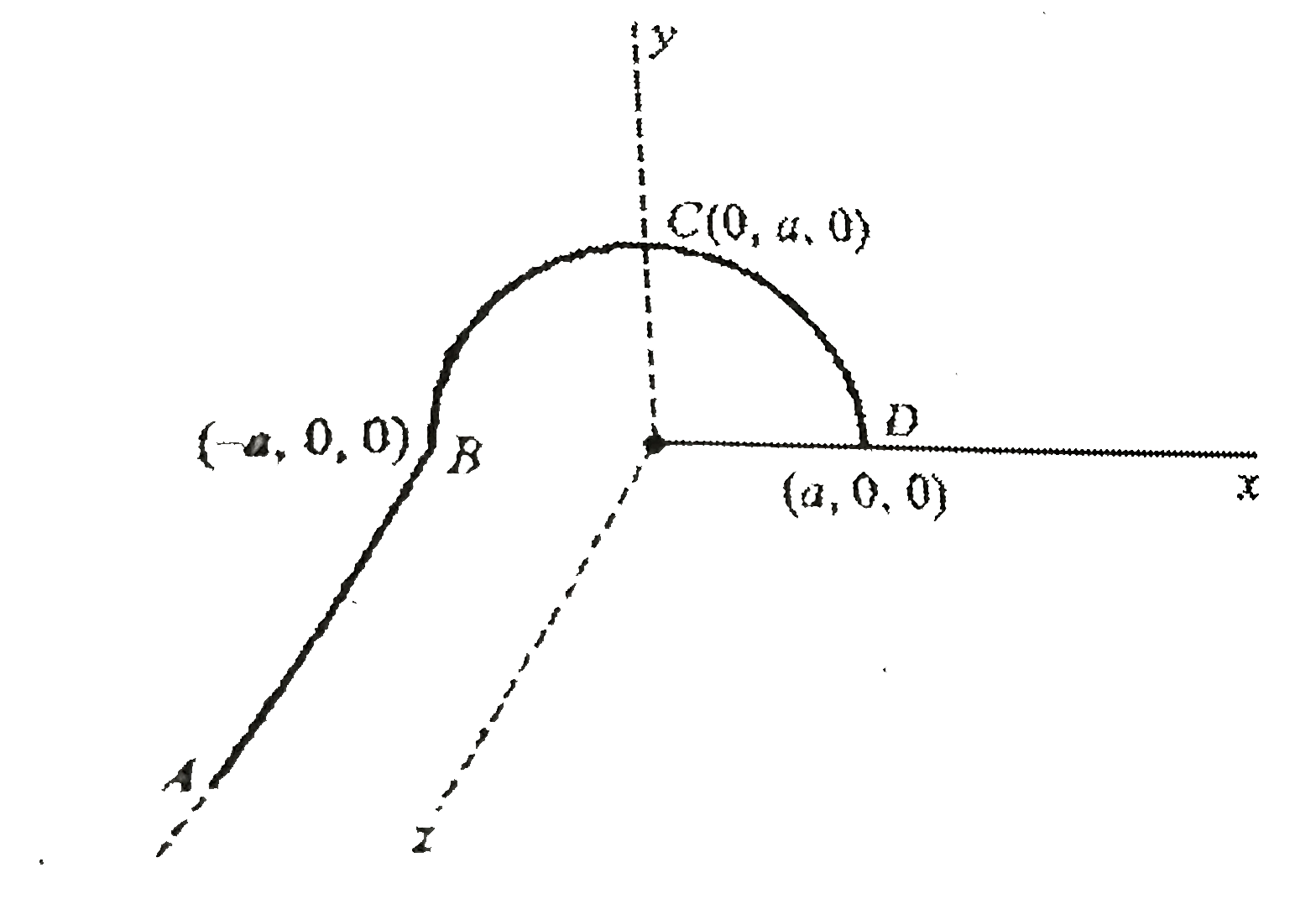 04:10View Solution
04:10View SolutionA point charge ` +q` & mass ` 100 gm` experiences a force of ` 100N` at a point of distance ` 20 cm` from a long infinite uniformly charged wire , If it is released find its speed when it is at a distance ` 40` cm from wire .
04:31View Solution
Unsolved Numberical Problems questions and complete solutions for chapter ELECTROSTATICS of GK PUBLICATIONS PHYSICS (HINGLISH) of Class 12
All Exercises from PHYSICS GALAXY Class 12 PHYSICS ELECTROSTATICS
- Advance MCQs
- Conceptual MCQs single option correct
- Discussion Question
- Illustrative Example
- Numerical MCQs Single options Correct
- Partice Exercise
- Partice Exercise 1.1
- Partice Exercise 1.10
- Partice Exercise 1.2
- Partice Exercise 1.3
- Partice Exercise 1.4
- Partice Exercise 1.5
- Partice Exercise 1.6
- Partice Exercise 1.7
- Partice Exercise 1.8
- Partice Exercise 1.9
- Unsolved Numberical Problems
